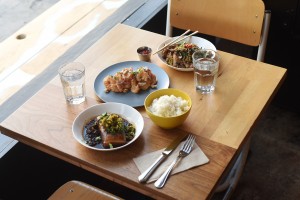David Kuo’s route to working in Michelin Star kitchens began with cooking in his fraternity house kitchen for Thanksgiving Iron Chef competitions.
Kuo graduated from UCLA in 2001, but decided to leave his office job working in property management. After enrolling in culinary school at Le Cordon Bleu and working in esteemed restaurants like Jean-Georges in New York, he opened his own rotisserie-style restaurant, Status Kuo, in 2014.
However, because his restaurant offered both Taiwanese and American dishes, he had trouble appeasing both sides of himself, he said. Two years later, Kuo rebranded his Mar Vista eatery from Status Kuo into Little Fatty, which opened Thursday. The new restaurant is accompanied by a bar, accomplice, run by Kuo’s partner and general manager Aaron Siak.
Little Fatty offers Taiwanese-Chinese cuisine while accomplice serves drinks and traditional American bar foods. Kuo said he hopes Little Fatty’s menu will reflect the food he grew up eating – Taiwanese Sunday gravy and breakfast porridge. He sources most of his ingredients from Taiwan to create more authentic dishes.
“There was a calling inside me that always wanted to cook Taiwanese-Chinese food,” he said. “The food that I liked to eat and the food that I crave.”
[Related: UCLA alum, students open Chinese restaurant Top Leaf in Westwood]
The white minimalist interior of Little Fatty contrasts the darker walls of accomplice as customers walk through an open doorway, evoking a yin-yang feel in the restaurant, said assistant general manager Tatia Oshidari. A colorful octopus mural is painted on the front of the kitchen counter, behind which metal bins of peppers, scallions and parsley are displayed.
Splitting the restaurant into an American-style bar and a Taiwanese-style restaurant allowed Kuo to focus on cooking the food that he’s passionate about, Siak said.
Much of Little Fatty’s menu is inspired by family recipes that Kuo tweaked by using ingredients from Japan and China coupled with some European culinary techniques, he said. The name comes from a nickname used endearingly by his parents and relatives, a call to his childhood.

“I kind of mish-mash my childhood and my experiences learning from top chefs,” Kuo said. “It’s got a lot more identity to it.”
One of his dishes, pork belly, is traditionally cooked for four hours and served with mustard greens or preserved vegetables, both of which are prepared through a lengthy process of salting and drying. Every Taiwanese family has their own version of the classic dish, he said.
Since he can’t accommodate 10 steamer woks in his kitchen like traditional Chinese restaurants, he cooks the meat in large batches in the oven. The meat stays in the oven for four hours and is served with ginger, garlic and scallion, a combination Kuo calls the Asian trinity. He buys the mustard greens and vegetables from local Asian markets.
[Related: Northern Cafe brings Chinese cuisine to Westside for students]
Kuo incorporates other Asian flavors in his dishes as well. His Taiwanese Sunday gravy is served with fish sauce and Japanese kombu, which he adds for a more savory flavor profile, he said.
Although some of his food is made using American-style ingredients and European techniques, he tries to source everything from Taiwan, he said. His tofu dishes use organic black bean soy paste from Taiwanese purveyors because of their deep, caramel flavor, as opposed to packets of soy sauce, he said.
[Related: Poke trend grows in Westwood with new restaurant opening]
To gain culinary research for potential dishes for the reimagined Little Fatty, he went on week-long trip to Taiwan in April, sometimes eating 10 different bowls of beef noodle soup in a day. He wanted to explore the idea of making his own fish and pork balls, instead of the packaged ones that are normally used. The best thing he ate on his trip was a fish ball stuffed with minced pork made by a street vendor, he said.
Long-time customer Vincent Seah served as the tour guide for Kuo and his sous-chef in Taiwan.
They drove up a mountain in Taipei to a noodle shop located in a rural village. The noodles in the shop were made from a wheat dough that was hand-pulled using bamboo rods then dried outside, Seah said. They were then dyed using ingredients like green tea or red dates for color. The process took about a day.
Kuo said the trip inspired him to eventually start hand-pulling his own noodles, and to learn more about Taiwanese cooking.
With Little Fatty, Kuo aims to create new versions of traditional dishes, while sourcing ingredients and techniques from Asian regions, Kuo said. He hopes to deviate from mainstream dishes while still being able to service everyone in the neighborhood, including people that may not be used to Taiwanese flavors.
“I just want to share the food with everybody,” Kuo said. “It doesn’t matter if you’re Taiwanese or American.”
